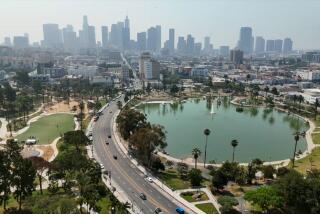Joining eastward march, Berggruen Institute plans second location in MacArthur Park
- Share via
Joining an eastward march that is steadily remapping the cultural landscape of Los Angeles, the 7-year-old Berggruen Institute announced Friday that it has purchased a 1924 building in the MacArthur Park district near downtown and hired the Spanish architecture firm SelgasCano to renovate it.
The public policy think tank, founded by 55-year-old billionaire philanthropist Nicolas Berggruen, is already planning an extensive campus in the Santa Monica Mountains, north of the Getty Center, to be designed by the Swiss firm Herzog & de Meuron.
For the record:
3:29 a.m. Jan. 24, 2025This article lists Preston Wright as the architect of the 1924 MacArthur Park building. It was designed by the firm Morgan, Walls & Clements.
“What we’re building in the mountains is a fairly quiet place,” Berggruen said in a phone interview Friday morning. “We wanted another location that will be better for public engagement.
“Equally important,” he added, “I felt that if we’re going to be on the Westside, we should really make a commitment to another part of Los Angeles. And my feeling, strongly, was that we should be east-facing, near downtown.”
His foundation joins a substantial list of museums, galleries and arts nonprofits that are setting up shop, relocating or adding satellite locations east of the 405 Freeway, including the Broad museum, the Maurice and Paul Marciano Art Foundation, the Institute of Contemporary Art Los Angeles (formerly the Santa Monica Museum of Art) and the Main Museum.
Twenty years ago this fall, the Getty Center opened on its Brentwood hilltop just west of the 405, solidifying a sense that locations in the moneyed Westside, with easy freeway access, were L.A.’s most desirable.
These days, however, cultural institutions are more interested in settling in denser parts of the city to the east, where they can be closer to a booming downtown and more easily reach what they perceive to be younger and more adventurous audiences.
Founded in 2010, the Berggruen Institute funds research on public-policy reform, culture and what it calls “intelligent governance.” The MacArthur Park location, occupied by architect Preston Wright’s two-story, Spanish Revival-style Westlake Square building, will house a combination of administrative space and areas for public programs and exhibitions, as well as room for scholars in residence. Berggruen estimates that it will open in two years; the Westside campus, he said, may take three times that long to complete. (The institute will also be leasing space in the Bradbury Building downtown.)
Though it needs significant work, the Westlake Square building, on the corner of West 7th and Carondelet streets, has plenty of architectural personality. It currently holds a letterpress company, a small bookstore and an even smaller mini-mart, among other tenants. Its facade is covered with a range of ornament, including a number of human faces peering down at the sidewalk. There is a small courtyard along the back of the building that Berggruen said the architects hoped to turn into a garden.
“The bones are very good,” he said. “It’s sort of a romantic building.”
He added that he had been looking for the right location in MacArthur Park for several months. “I’ve probably walked by every single building” in the neighborhood.
Finding an architect was easier for Berggruen, who follows the field closely and — with two major commissions underway — now ranks among the city’s most ambitious patrons of contemporary architecture.
“They were the first people I called,” he said, referring to SelgasCano, a Madrid firm founded in 1998 by the husband-and-wife architects José Selgas and Lucía Cano.
The firm’s work is cerebral and playful at the same time, its clean lines combined with a palette of bright, often primary colors. Its best-known projects include the 2015 Serpentine Pavilion in London, designs re-imagining the contemporary office for the company Second Home and a performing arts center in Cartagena, Spain.
Asked if he anticipated the sort of backlash from longtime residents that has greeted new galleries and cultural centers in Boyle Heights and other gentrifying areas of the city, Berggruen replied: “MacArthur Park is an area that will transform with us or without us. You might as well do it in a way that is productive and dignified.”
SIGN UP for the free Essential Arts & Culture newsletter »
Twitter: @HawthorneLAT
More to Read
The biggest entertainment stories
Get our big stories about Hollywood, film, television, music, arts, culture and more right in your inbox as soon as they publish.
You may occasionally receive promotional content from the Los Angeles Times.











